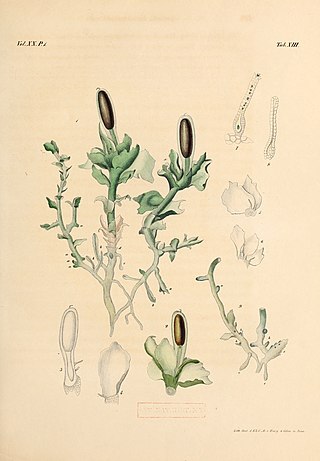
The Marchantiophyta are a division of non-vascular land plants commonly referred to as hepatics or liverworts. Like mosses and hornworts, they have a gametophyte-dominant life cycle, in which cells of the plant carry only a single set of genetic information.

Hornworts are a group of non-vascular Embryophytes constituting the division Anthocerotophyta. The common name refers to the elongated horn-like structure, which is the sporophyte. As in mosses and liverworts, hornworts have a gametophyte-dominant life cycle, in which cells of the plant carry only a single set of genetic information; the flattened, green plant body of a hornwort is the gametophyte stage of the plant.

Jungermanniales is the largest order of liverworts. They are distinctive among the liverworts for having thin leaf-like flaps on either side of the stem. Most other liverworts are thalloid, with no leaves. Due to their dorsiventral organization and scale-like, overlapping leaves, the Jungermanniales are sometimes called "scale-mosses".

The Notothyladaceae is the only family of hornworts in the order Notothyladales.

Jungermanniopsida is the largest of three classes within the division Marchantiophyta (liverworts).
Folioceros is a genus of hornworts in the family Anthocerotaceae. The genus is common locally in the tropical and subtropical regions of Asia, growing on moist rocks, in fallow fields, and near waterfalls. It has a yellow-green gametophyte thallus that is crispy and translucent, with short branchings that are almost pinnate. Plants are usually less than a centimeter wide and 3 centimeters long. They may be monoicous or dioicous.

Herbertaceae is a family of liverworts. The family consists of the genera Herbertus, Schisma and Triandrophyllum. The genus HerpocladiumMitten, 1873 was later merged into the genus Herbertus.

Blasiales is an order of liverworts with a single living family and two species. The order has traditionally been classified among the Metzgeriales, but molecular cladistics suggests a placement at the base of the Marchantiopsida.
Leiosporoceros dussii is the only species in the hornwort genus Leiosporoceros. The species is placed in a separate family, order, and class for being "genetically and morphologically distinct from all other hornwort lineages." Cladistic analysis of genetic data supports a position at the very base of the hornwort clade. Physical characteristics that distinguish the group include unusually small spores that are monolete and unornamented. Additionally, there are unique strands of Nostoc (cyanobacteria) that grow inside the plant parallel with its direction of growth. Unlike other hornworts with symbiotic cyanobacteria that enters through mucilage clefts, the mucilage clefts in Leiosporoceros is only present in young plants and then closes permanently once the cyanobacterial colonies have been established. Also mycorrhiza and pyrenoids are absent. Male plants have been found in Panama.
Cryptothallus is a previously recognized genus of liverworts in the family Aneuraceae. The plants are small, and are white to pale green as a result of lacking chlorophyll. This feature led to the creation of a separate genus. The morphology of species assigned to Cryptothallus is very similar to that of Aneura. As a result, Karen Renzaglia in 1982 suggested that the only species then placed in the genus, Cryptothallus mirabilis, may be considered "merely as an achlorophyllous species of Aneura." Wickett and Goffinet argued the same position on the basis of sequences of nuclear, mitochondrial, and plastid DNA, and moved Cryptothallus mirabilis to Aneura. A 2010 molecular phylogenetic study confirmed the position of Cryptothallus within Aneura. This was accepted in the 2016 world checklist of hornworts and liverworts.

Pleurozia is the only genus of liverworts in the family Pleuroziaceae, which is now classified in its own order Pleuroziales, but was previously included in a broader circumscription of the Jungermanniales. The genus includes twelve species, and as a whole is both physically distinctive and widely distributed.

Solenostomataceae is a family of liverworts in the order Jungermanniales.

The Anthocerotaceae is the only family of hornworts in the order Anthocerotales.

Acrobolbaceae is liverwort family in the order Jungermanniales.

Gymnomitriaceae is a liverwort family in the order Jungermanniales.

Haplomitrium is a genus of liverworts.

Calypogeiaceae is a family of liverworts. This type of plant is a calcifuge.

Fossombroniales is an order of liverworts.

Ptilidiales is an order of liverworts.
Cleveaceae is a family of liverworts belonging to the order Marchantiales.













